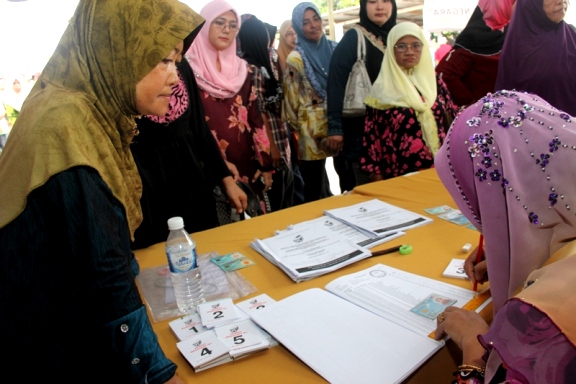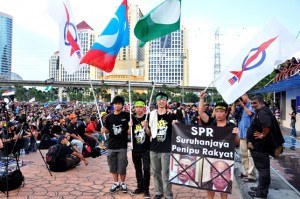COMMENTS: The re-delimitation of constituencies in carried out in 1958, 1966, 1974, 1983, 1992 and 2003.
According to the Federal Constitution, under Article 113, the Election Commission (EC) has been entrusted to conduct a review on constituency boundaries every 10 years.
The boundary re-delimitation is based on the geographical and topographical situation of an area, the level of development demographics, basic utilities and communication.
It is also based on the ability of the Government (State and Federal) to cover the costs involved in adding Parliamentary and State seats.
The purpose of the boundary re-demarcation is done to ensure that imbalance of a populate area which complicates administration does not happen due to the increase in population.
This more evidently happens in urban areas due to the increased development that leads to the active migration of residents.
But the main basis of the redistribution, whether at the Parliamentary or State Level, should be aligned to the rationality of the total voters, the breadth of the boundary area and accessibility that can facilitate the people’s representatives to contact and serve the voters.
Based on the previous delimitation in 2003, the EC has no other choice but to do it this year. Although there were suggestions to carry it out in 2011, the EC gave excuses to carry it out after the GE-13 because they do not want to interfere with the said election.
Whatever the reason, the EC is under the Prime Minister’s Department (JPM) which has the power to determine the date and time to review and to ready the new boundary delimitation.
‘Gerrymandering’ Saves Najib
During the GE-10 in 1999, the Pekan Member of Parliament who is now the Prime Minister, Datuk Seri Najib Razak, won the seat with a majority of 241 votes.
Due to the redistribution in 2003, the EC included several military camps, which were previously in the Kuantan parliamentary area, into the Pekan parliamentary constituency.
Since then, when Najib was the Minister of Defense, he has won comfortably in every General Election despite the Kuantan Parliament being finally compromised to Pakatan Rakyat since the 2008 GE till now.
This is one of the methods used by the EC to ensure great victory for Umno-BN in the GE after the boundary re-delimitation.
Even thought through this method, other areas have to be given up to the opponent.
In a Social and Political Sciences study, the method used by the EC to continue Najib’s victory is referred to as “Gerrymandering”.
Gerrymandering is an act of manipulating those who have political power in a country/state in restructuring and reorganising the administrative areas to influence the outcome of the upcoming election.
This action is intended to reduce the opposition’s votes and enable the ruling party to secure more votes than the previous results.
The Gerrymandering method was founded by the Governor of Massachusetts in the United States from the Republican Party, Elbridge Gerry, when he dominated the region in 1812.
Gerry approved a legal policy related to the delimitation of constituencies in his region which was in favour of his party.
His action is also known as Salamander because the changes he made to the region caused the map to resemble the shape of a “Salamander”.
Three Tactics to Destroy Pakatan
There are three methods to manipulate the delimitation of constituencies to give an advantage to the ruling party.
First is the concept of ‘Excess Vote’ where Pakatan will be limited to dominate a particular area with the advantage of a great majority. Meanwhile, the surrounding areas that voter for the opposition will ‘sink’ in the ruling party’s majority vote.
For example, Kelantan is an area that strongly supports PAS, which is why the Central Government will try to concentrate on Pahang and Terengganu in the election to ensure that the two states would not be captured by PAS.
This means that the government party will limit the power of opposition parties to only the state of Kelantan.
Second, is the ‘Wasted Vote’ method which is an effort to reduce the votes of the opposition by entering regions that BN is expected to win into the areas controlled by PR.
For example, in area A, the populous supports PR while in area B, most support BN.
To ensure that BN can win in area A, a restructuring is made by inserting one or more parts of area B into area A and to remove a part or excess of area A to area C.
This move will allow BN to win in the next election with a ratio of 1:2.
The third is through “stacked deck” money method. Through this method, areas that are far from cities will be made fortresses of the ruling party to remain in power.
This concept can be likened to a ‘debt’ concept where the ruling party will use money and bribery to develop and improve the infrastructure facilities in rural areas.
The customs and culture of rural communities are manipulated to place villagers in a debt and they need to be grateful to the government.
The government will also threaten the rural community with the notion that by supporting the opposition, they will face problems because most of the rural population consists of poor people.
EC’s Delimitation Stabs BN
Before the political tsunami in 2008, BN used ethnic influence as an asset of victory in every General Election and by-election.
BN often relied on Chinese and Indian voters to ensure a comfortable victory.
However, after the 2008 uprising wave where nearly 90 percent of the Chinese ethnic and over 54 percent of Indian voters supported PR, placing BN and the EC in a quandary to redraw new boundaries.
Meanwhile, the 51 percent popular vote victory towards PR and only 47 percent for BN in the GE-13 has become a benchmark that the effect of the boundary re-delimitation carried out by the EC all this while has backfired.
Based on the Gerrymandering method, the government’s methods of manipulating new-constituencies have unhealthily caused long-term internal problems that adversely affect the ruling party.
This is due to the non-factual results from the actual results, but the effects of unfair manipulation of boundaries.
EC Dilemma
This is also the reality of what the EC and Najib are facing to ensure tremendous victory in the GE-14 after the re-delimitation as has happened before.
The EC can guess the redrawing of constituencies based on observing the victory in certain channels won by BN in the last GE-13.
The ‘Waster Vote’ method used previously has contributed to BN’s victory despite failing to obtain two-thirds in parliament.
One of the big differences to the re-delimitation this time is that the ethnic factor can no longer be made a backup by the EC to ensure BN’s victory.
The big issue of this seventh re-delimitation in 2013 is the imbalance of the number of voters in the bounded area.
Meanwhile, the purpose of the re-delimitation should be to avoid imbalance in the size of the area and the number of voters.
For example, P125 Putrajaya has a total of 15,791 voters while P109 Kapar has 144,369 registered voters. Kapar has ten times the number of voters from Putrajaya while the two areas are respectively represented by one representative of the people.
The second dilemma faced by the EC is related to how many additional State and Parliamentary seats are there throughout the country. Can the 222 Parliamentary and 505 Constituency seats contested in the GE-13 be maintained?
And if the additional seats will be favour of Umno BN or give victory to PR.
Be it secretly or openly highlighted, the EC is a junta where BN coalesce to ensure the continuity of power.
The redrawing of the election constituencies which has not changed are the odds, gamble and EC mechanisms to ensure BN’s victory.
This is the effect when the agency lost its credibility and public confidence towards the body which was purposely designed for the benefit of Umno-BN.
Would Najib’s government dare to place the EC under the authority of the Parliament, as being fought by the people for so long?
The answer is that we can only wait and see for the moment.








